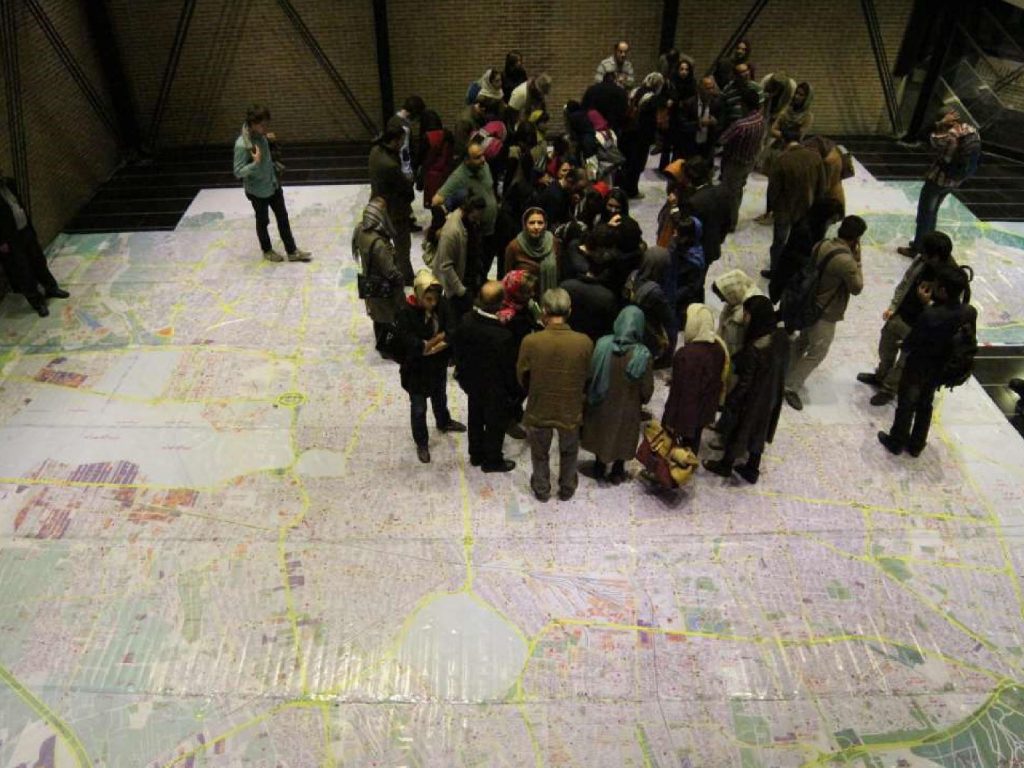Performance / Installation Tehran 2013-2014
Firstly – Tehran is motion; we stand on a continuous motion; a constant fluctuation of something into something else. This instability is the stability in Tehran. In a changing situation, we attempt to steady our relations with one another, and to compare and contrast our “being” with others. Hang-outs change from time to time. Houses are relocated, and people move in clusters on the highways from east to west and from south to north. Where on the ground have we fixed our feet? Where in Tehran are we standing? We are standing, on the unsteady soil of Tehran, in a continuous potential for change, on “motion”.
Secondly – A metropolis like Tehran is not reducible to a single image. The chaos of Tehran allows this subjectivity: my Tehran, your Tehran, her Tehran … Despite this, the dream of finding a unifying definition of Tehran never leaves us. This need for unification triggers our struggle to establish a one to one relationship with the city. We accept the simple and merciless aspect of Tehran to end the confusion in our relation with it: in our neighbourhood, our cars, our clothes, the bills in our pockets.
Thirdly – We do not know our relationship with other Tehranis, it still remains vague, and depends on collective arrangements, national fury or reconciliation, and the occurrence of events. Public spaces are under control, but only subconsciously. When the control becomes conscious, shock and disbelief follow. Relations with others are another solution for stability in Tehran. This is where we stand in Tehran: on our relations with the others of Tehran. A relationship, filled with coincidence and choice.
Fourth – We have simplified this phenomenon to an event, shortened and downgraded it into an evening play at a gallery in northern Tehran. We have minimized Tehran to the size of the gallery floor, and reduced its citizens to the audience. We know all that we see, although we have not yet seen them. We are all related to Tehran. Tehran stands between us. Our relation with each other is defined through our relation with Tehran. “Demarcation” is a game of becoming familiar, exposing, and making this distance explicit. Our relation with Tehran is that of a minority taken out of city squares and put together in indoor halls.
The show is performed on a huge map of Tehran 10mx13m. The audience enters the hall in groups of 25 to 40 people. In the beginning, a performer asks participants to find their homes on the map and stand on it. Eventually, the performer asks 10 other questions. For each question people have time to find a place of their answers. Questions are like: Where did you go to primary school? Where did you get lost? Where did you dance on the streets? Questions are about the past, present and future. Some of the questions refer to collective memories and some of them have individual answers. Participants walk on the map, remembering and finding places. There is a camera on the ceiling that takes a photo of each constellation following the questions. The last question is: Where do you see yourself in ten years? When people start to position themselves in space, the light fades out and photos which were taken during the show will be projected on the wall with subtitles. These are formatted in the following way: Distance + title of the distance+ the scale of the map. For instance: “Our distance when we went to primary school – scale: 1.2500”.
Ten questions of the show are: Where do you live in Tehran? Where did you live in Tehran before that? Where did you go to primary school? Where do you like to live in Tehran? Where did your happiest memory happen? In which street did you dance? Where did you get scared? In which street did you get lost? Which part of the city do you hate? Where do you see yourself in 10 years?
